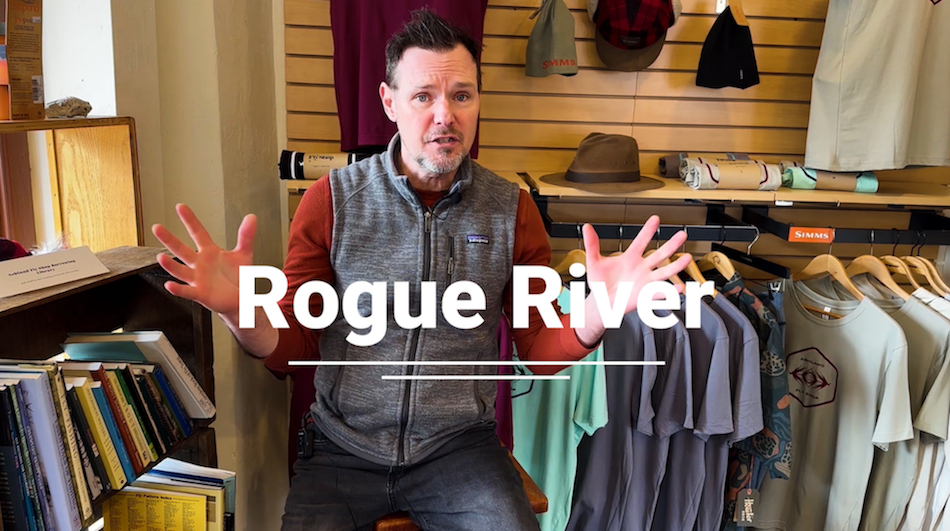Your Cart is Empty
free shipping on all domestic orders over $75

Jon's Notes
The past couple of winters have been pretty rough on us. There haven’t been too many “good” windows of opportunity as it relates to fishable water conditions. I have been guiding winter steelhead trips in Southern Oregon for over 15 years. Over time, I have learned what river flows are ideal for swinging flies, and what those limitations are. For example, I am confident fishing up to 4500 CFS on river “X”. I know that there will be quality fly water available and can make a good day of it. I know what runs will look good and plan my trips accordingly.
This year I have been forced to seek out new water and push those boundaries. I preach a lot about adapting to the flows (see High Water Tactics series), finding fishable water, and making it work. My limit on river “X” used to be 4500 CFS, now it’s 7,000! I’ve had to practice what I preach, and it’s working! Sure, instead of fishing 10 spots throughout the course of a day, I might be limited to 5. But, if you can find 5 good spots and cover them well, isn’t that better than not fishing at all? Steelhead swing (or Spey) water is defined as moderate depth, moderate speed. Find that at any flow, and you are in the game.
That scenario played out this week. I had a new customer fly out from Utah who wanted to learn the Spey game. Sure, everyone wants to catch fish, but his goal was to figure out as much as possible in three days. High water, he didn’t care. Catch a bunch of fish, no worries. Get schooled, absolutely.

We fished hard for three days. The first day we floated 12 miles to find 5 good spots. We had several grabs that day, one that appeared to be a steelhead. The second day, on a dropping river, we fished a different beat. Again, we only fished a handful of spots. One run in particular, he hooked two steelhead. The first one broke off as the shooting line was tangled around the reel knob. The second came unbuttoned. The third day, as the river was on the rise and blowing out, he hooked two more fish. Both we on briefly, neither saw the net. The last fish was hooked in brown water with less than a foot of visibility.
The moral of the story? Play the hand you’re dealt, push your limitations, and seek out new water. In the end, it payed off. In years past I may have postponed that trip. Glad I didn’t this time. “You won’t know if you don’t go” says my guide bro Dax Messett.
Fishing high water often means tight quarters. I prefer shorter rods like the new Sage X 7120 (12’ 7 weight) because there’s less rod to hit the willows behind you. I’ve had this rod since last fall, and have to say it’s quite amazing. I have played with a few different lines and am currently really liking a RIO Skagit Max 525. This rod is an absolute weapon. You can fish it in tight quarters or on open water. If you need to jack a 90 footer or pick apart a technical, small river, the Sage X 7120 is the rod.

My other favorite, a rod I’ve had a couple of years, is the Sage Accel 7136 (13’6” 7 weight). Unlike the X series, the Accel is more medium action. At 13’6”, this rod bends deep and delivers the fly with a smooth transfer of power. I prefer a RIO Skagit Max 500 combined with a sink-tip at least 12 feet in length. At 13’6”, shorter sink-tips are prone to create a blown anchor when combined with a regular Skagit Max.
In most high water situations, fish are holding or moving along the edges. So, dredging isn’t necessary. We fished mostly 10-12 feet of T-14, and a 5/5 MOW Medium in the shallow riffles and slower tailouts. There were a few spots where we used a RIO IFlight. The IFlight is a multi-density Skagit line that is 2/3 intermediate and 1/3 floating (in the back). Combined with a sink-tip out front, the IFlight gives you the ability to get deep and really slow down the swing. The intermediate portion of the line cuts through the surface tension. The back floating portion allows you to mend and acts as a “rudder”. This line system accounted for a couple of steelhead encounters.
It didn’t seem to matter what flies we had on. In fact, all four steelhead that we encountered ate different flies: Pick yer Pocket (black), Hot Hare (blue), Dirk Wiggler (black/red), Deuce Wigalo (blue). We got grabbed on a Hoh Bo Spey (orange/pink), Dirk Wiggler (pink), and several others. It’s a good reminder that when fish are around, they don’t care what fly it is, within reason, of course.
Final thoughts? Push the limitations, believe in what you are doing, play the hand you are dealt, and who knows, it might just work!

Marcus' Notes
Winter steelheading keeps you on your toes as an angler. Because of the excess rainfall, each time you head to the river is basically like fishing a new piece of water. Somedays the river is low and clear, high and clear, high and colored, or dropping and clearing. Somewhere in this crazy mixture of conditions, determined anglers attempt to crack the ultimate code: landing a wild fish that is full of energy. This was the pursuit I embarked on last weekend on the North Umpqua. We have some pretty legendary rivers speckled around the west coast, but the North Umpqua is among the most sought after. The fish there are often big and brutish fighters. Coupled with the rugged terrain and steep river channel, this is truly a world-class fishery in my opinion.
I spent the weekend getting to know my new Jefferson Rod Co 8136-4. It’s definitely a big stick for a river where most of the casting is in tight quarters, but it performed beautifully. I fished the RIO 575 grain Skagit Max regular with 10 feet of T-17 the entire weekend. Even with a large or X-Large dumbbell eye fly, this rod handled it with ease. The one major takeaway for me was learning how fine the line is between too much anchor stick and too little when attempting to cast such heavy rigs. Basically, you have to be casting in completely constant motion so that your tip and huge fly with lift out of the water with ease. It took me a few hours to adjust my stroke, but once I did I really found the groove with the rod.
As in many trips up North, this one did not produce any silvery scaled ghosts. But it did provide some much needed time on the river with friends and quality time with my new winter rod. For those of you who are feeling a bit of cabin fever this winter and spring, don’t be shy in testing your luck out there. Although we didn’t catch any steelhead, we did see two large fish roll while out on the water. The fish are in, it’s just a matter of finding them in all that water!




A February fishing report from Will, covering current and upcoming river and weather conditions on the Rogue, Applegate, Umpqua, and several rivers in northern California!

